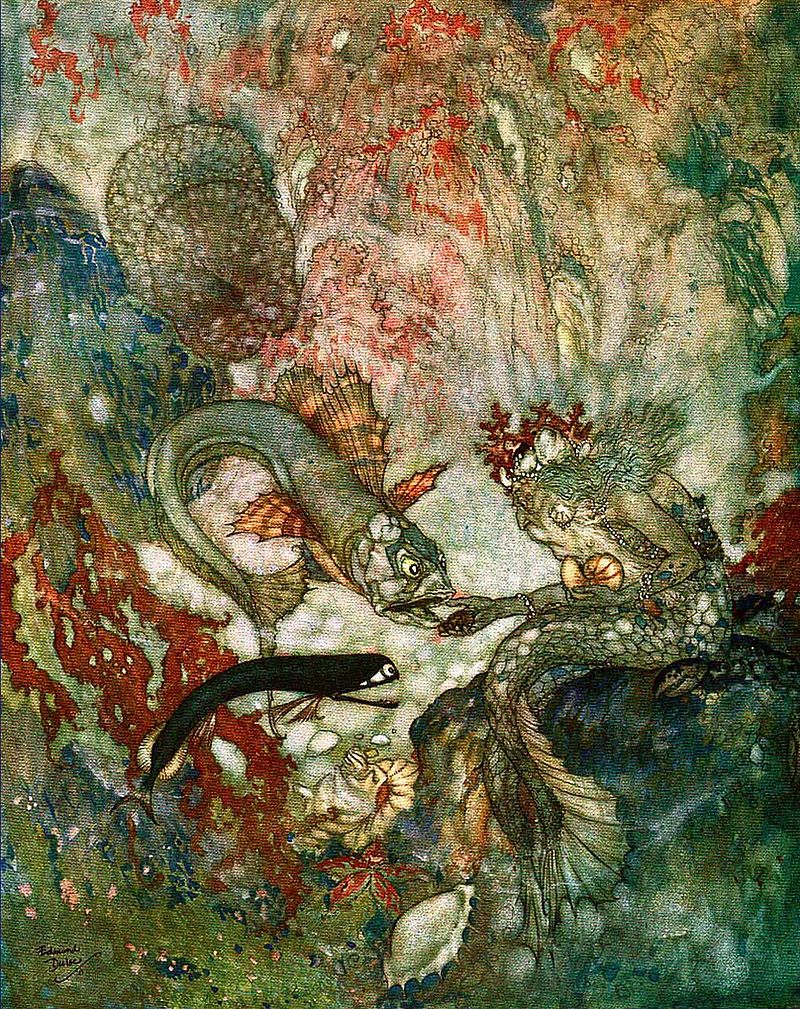Locathah

This lean humanoid bears crested fins on its head and back, and has the wide-eyed and wide-lipped face of a fish.
Simple aquatic creatures shunned by landwalkers and undersea folk alike, locathahs live in tight-knit communities scattered throughout the world’s seas, lakes. and waterways. Locathahs possess scaly ochre skin tinged with green and yellow. Ridged, rust-colored skin covers their chests and stomachs, and a mottled wash of green, brown, and orange colors their fins like aging kelp. Locathahs exude a strong fishy odor when above water that, in addition to their already unnerving appearance, repulses most land-dwellers. Despite this animosity, locathahs go to great lengths to befriend surface folk, offering safe passage through the waters, pointing out dangerous reefs, and hinting at sunken treasures in return for durable ceramics and metal tools and weapons, as well as tubers, which they view as a delicacy.
These creatures dislike combat and flee when disarmed or outnumbered. Locathahs hold community in the highest regard, never leaving a friend behind and often going to great lengths to retrieve a fallen companion. Among their own kind and races friendly toward them, locathahs are social creatures who live a very human-like, albeit simple, lifestyle. Locathahs work in stone, coral, and bone to produce the crude implements they use. Some take coral work to obsessive levels, with certain clans taking generations to grow their preferred medium in its desired form before carving it. They feed on crustaceans, undersea plants, and shellfish, and rarely on large fish that are caught during ritualized hunts.
Locathah matriarchs serve their undersea tribes not only as chieftains, but also as the primary egg layers of the community. Each adult member of the tribe is responsible for raising a single young locathah as his or her own. Locathahs tame moray eels, keeping them near their lairs as humans keep dogs. Some locathah soldiers and hunting groups use giant moray eels as mounts, chasing down their quarry and attacking with narrow-tipped spears. More powerful aquatic races use locathahs as slaves, abducting breeding matriarchs to produce a constant wave of new workers.
Locathah stand roughly as tall as humans, yet their fins jut out, giving them an imposing stature. Lean and strong, locathahs weigh roughly 160 pounds.
| Locathah | |
| Medium humanoid (Aquatic) | |
| Hit Dice | 2d8 (9 hp) |
| Initiative | +1 |
| Speed | 10 ft. (2 squares), Swim 60 ft. |
| Armor Class | 14 (+1 Dexterity, +3 natural), touch 11, flat-footed 13 |
| Base Attack/Grapple | +1/+1 |
| Attack | longspear +2 melee (1d8/x3) or light crossbow +2 ranged (1d8/19-20) |
| Full Attack | longspear +2 melee (1d8/x3) or light crossbow +2 ranged (1d8/19-20) |
| Space/Reach | 5 ft./5 ft. |
| Saves | Fort +3, Ref +1, Will +1 |
| Special Attacks | – |
| Special Qualities | – |
| Abilities | Strength 10, Dexterity 12, Constitution 10, Int_13, Wisdom 13, Charisma 11 |
| Skills | Craft (any one) +6, Listen +6, Spot +6, Swim +8 |
| Feats | Weapon Focus (longspear) |
| Environment | Warm aquatic |
| Organization | Company (2-4, 1-2 Giant Moray Eels), patrol (11-20 plus 2 3rd-level sergeants and 1 leader of 3rd-6th level, 5-8 Giant Moray Eels), or tribe (30-100 plus 100% noncombatants plus 1 3rd-level sergeant per 10 adults, 5 5th-level lieutenants, and 3 7th-level captains, 7-12 Giant Moray Eels) |
| Challenge Rating | 1/2 |
| Treasure | Standard |
| Alignment | Usually neutral |
| Advancement | By character class |
| Level Adjustment | +1 |
Habitat and Society
Locathahs view community as very important, and go to great lengths not to abandon their fellows. They live a simple lifestyle, making crude tools out of stone, coral and bone. They try and trade their knowledge of the local sea conditions with surface dwellers in return for ceramic and metal items.
They eat mainly undersea plants and shellfish, supplementing this with occasional fish. They also enjoy eating tubers, when they can obtain them.
Each tribe is led by a matriarch, who also serves as the main egg layer. Every adult then raises one of the young as their own. They often tame moray eels, and warriors may use giant eels as mounts. They speak Aquan.
COMBAT
Any battle with locathahs usually begins with the creatures loosing volleys of bolts from their crossbows; underwater, their crossbows have a range increment of 20 feet. If they have managed to set up an ambush or other trap, they continue to employ crossbows for as long as possible. Otherwise, they close to bring their longspears into play. Although primarily used for fishing, these spears make formidable weapons.
Locathahs lack teeth, claws, and other natural weapons, so they are not especially dangerous if unarmed. A weaponless locathah will generally turn and flee.
Skills: A locathah has a +8 racial bonus on any Swim check to perform some special action or avoid a hazard. It can always choose to take 10 on a Swim check, even if distracted or endangered.
It can use the run action while swimming, provided it swims in a straight line.
Section 15: Copyright Notice – Bestiary 2
Pathfinder Roleplaying Game Bestiary 2, © 2010, Paizo Publishing, LLC; Authors Wolfgang Baur, Jason Bulmahn, Adam Daigle, Graeme Davis, Crystal Frasier, Joshua J. Frost, Tim Hitchcock, Brandon Hodge, James Jacobs, Steve Kenson, Hal MacLean, Martin Mason, Rob McCreary, Erik Mona, Jason Nelson, Patrick Renie, Sean K Reynolds, F. Wesley Schneider, Owen K.C. Stephens, James L. Sutter, Russ Taylor, and Greg A. Vaughan, based on material by Jonathan Tweet, Monte Cook, and Skip Williams.

 Buy me a coffee
Buy me a coffee